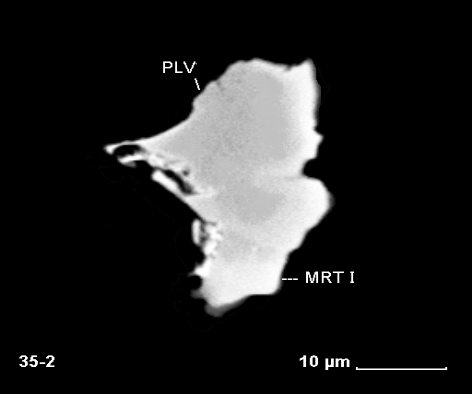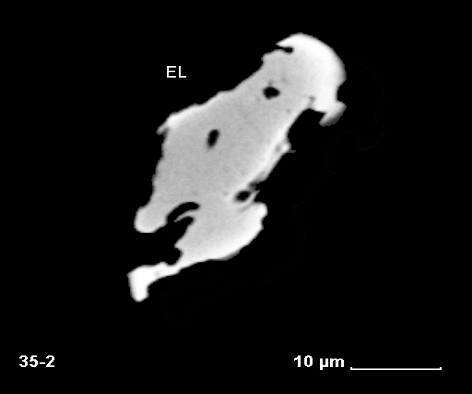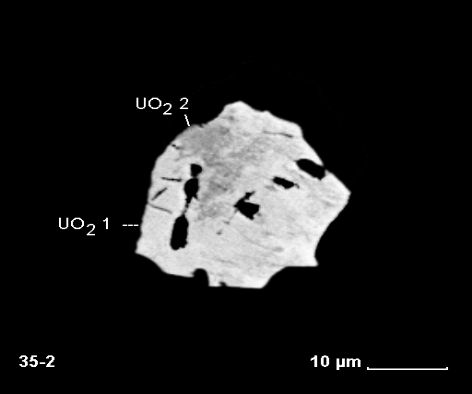Platinum Group Minerals in Kodar-Udokan complex (Eastern Baikal Region)
Introduction
The various manifestations of platinum metal mineralization there are known in Kodar-Udokan depression: in Chyney layered intrusive, Early Proterozoic cuprous sandstones of Udokan deposit and as well in blackshale complex. One more type of such mineralization is characterized below. It is revealed in the upper part of section of Chyney series of Udokan complex. Numerous albite bodies presented as convergent intersecting thin lenses and veins of variable thickness (up to several meters) and composition are spread here. They have gradual intertransitions and indistinct contacts with enclosing tectonized and graphitized aleurosandstones of Alexandrov formation.
|
Location of Kodar-Udokan depression in geological structure of Baikal region
|
|
 |
Notation on inset map and scheme:
СП- Siberian platform; БСО -Baikal folded area; АЩ - Aldan shield; КУ- Kodar-Udokan depression. 1. Early Proterozoic Udokan complex (a – particoloured, b – carbon-bearing formations ); 2. Archean Chara complex; 3. Proterozoic formations of БСО; 4. Deposits: 1 – Udokan deposit, 2 – Deposit of Chyney group; 5. The studied area of distribution of albites and conjugated metasomatites.
Disposition of noble metal mineralization in section of Udokan complex:
Particoloured molasse formation of Kamensk series (km); 2-3. Particoloured flyschoide formation of Chyney series (cn), among them: carbonaceous(2) and terrigenous(3) formations; 4. Carbon-bearing formation of Kodar series (kd); 5. Gabbro-norites of Chyney intrusion; 6-9 Types of noble metal mineralization: 6-Pt-Pd in cupper-sulphide ores; 7-Pd in cuprous sandstones; 8-Pd-Pt(?) in black shales; 9-Pd in albites and albitizationed rocks; 10-tested level of albitite occurrence.
Formations:
ik–ikabiy formation; an-ajansk formation, in-inyr formation; ct–chytkundyn formation; al-alexandrov formation; bt–butun formation; sk–sakoukun (italakun) formation; nm–namyngyn formation.
|
Mica (sericite, more rarely biotite) and chlorite are permanently met in rocks. Chlorite more frequently forms veinlets and schlierens where sulphide minerals are concentrated: chalcopyrite, pyrite, arsenopyrite, molybdenite. Albitites are uranium-bearing. The contents of uranium in them can reach the tenth parts of percent. Uraninite is the concentrator of uranium which is presented by two forms – by uranitite itself and by more recent pitchblende as reniform aggregates. Availability in section of Udokan complex of albites and conjugated with them metasomatites along with uranitites and titanates of uranium is special feature of Kodar-Udokan depression [1].
By FAAS analysis in heavy concentrates (HC) ( see section Technics, "ppm-mineralogy”) is revealed that albitites are specialized on palladium. Contents of palladium ap to 1.3ppm with gold concent 0.2ppm. Content of platinum is lower than a detection threshold. Essentially palladium rock specialization is confirmed by mineralogical analysis based on techniques “ppm-mineralogy” on sample mass 6g. As a result were revealed more than ten grains of palladium phases. They can be to some extent conventionally identified as sobolevskite, froodite, mertieite and paolovite. Besides that from the group of noble metal minerals were revealed electrum and hessite and from base minerals in heavy concentrate – chalcopyrite and uraninite.
|
Minerals. Back Scattered Electron Microscope Images
Clicking on images provides the higher resolution ones
|
||||
|
1
|
Xenomorphic grain of chaotic microintergrowths of sobolevskite (SB - PdBi) and froodite (FR -PdBi2). Chemical composition varies within the limits of each phase breaking down stoichiometric relations in formulars.
|
|
2
|
Xenomorphic heterogeneous by chemical composition grain of sobolevskite (SB1, SB2 - PdBi). Chemical composition within the limits of each phase varies and stoichiometric relations are not permanent.
|
|
3
|
Xenomorphic heterogeneous by chemical composition grain of sobolevskite (SB1, SB2 - PdBi). Chemical composition within the limits of each phase varies and stoichiometric relations are not permanent.
|
|
4
|
Xenomorphic heterogeneous by chemical composition intergrowth(?) of paolovilite (PLV, Pd2Sn) and merieite-I (MRT, Pd~11(Sb,As)~4). There is not distinct phase boundary between minerals. Sb is present in PLV. Sn is present in MRT.
|
|
5
|
Xenomorphic grain of electrum AuAg.
(We shall admit the potential of “ppm-mineralogy” technology: it has revealed the gold-bearing mineral in 6g sample with gold content in 0.2ppm!).
|
|
6
|
Microinclusion of hessite (HS, Ag2Te) in chalcopyrite (CP, CuFeS2). We can meet in chalcopyrite besides hessite looking alike small inclusions of galenite.
|
|
7
|
The grain of uraninite (UO2) heterogeneous by chemical composition: the proportion of Pb is larger in bright parts than in dark ones. Relation Pb/U in this(!) grain varies from 0.134 up to 0.344 which corresponds to absolute age 0.8 and 1.87 GA.
|
|
8
|
Uraninite grains in heavy concentrate of sample K-52. Distinctions in brightness and “spottness” is conditioned by variations of composition in relation Pb - U: 1 – Pb/U=0.349, 2 – Pb/U=0.245.
|
Discussion
Revealed by microprobe analysis phases containing palladium are distinctly different, but chemical composition within the limits of grains varies and stoichiometric relations in formulars not permanent. Besides that there are no distinct phase boundaries between adjoining minerals. And microspotted impregnation of one mineral in the other is rather typical (photo 1-3). The indicated features allow suspecting that the real sizes of individual palladium phases are so small that even microprobe analysis does not provide sufficient localization and revealed minerals represent aggregates of submicron phases. Rather likely such aggregates would arise either or both at crystallization of primary amorphous masses and at recrystallization of primary palladium-containing phases. This process was accompanied by the destroying of crystalline lattices under the influence of late unbalanced processes. The last presumption corresponds with existing notion about stage formation of albitites and ore minerals in it. The occurrence of incrusted nodular types of uranium minerals caused by late hydrothermal processes demonstrates that in particular.
Simultaneously with investigation of platinum group minerals was analyzed composition of uraninite. This allowed us to make assessment of absolute age of albite mineralization by value Pb/U [2]. Reliability of such assessment is rather high on under conditions that: 1). Lattice of mineral at formation of uraninite does not include plumbum as isomorphous component and 2). After formation of uraninite the subsequent processes does not cause subtraction of lead derived from radioactive decay of uranium. It is obviously, that the similar conditions are seldom enough in natural systems.
By microprobe analysis of more than 20 grains of uraninite from different samples have shown that concentration of Pb and U in minerals vary from 68 to 79 for uranium and from 20 to 9 wt.% for lead. It was revealed that composition of uraninite differs not only in separate grains but within one grain as well (photo 7, 8). Herefrom we can make a conclusion about Pb removing from uraninites by more late processes in relation to the age of crystallization. That is also indicated by observed unconsolidated porous structure of minerals. The minimum value of lead-uranium relation equal 0.134 corresponds to 800 million years. However, the maximum concentration of Pb and the corresponding values of relation Pb/U in uraninites from different samples are close enough: 0.344 – 0.349 and corresponds to 1.87-1.90 GA.
Under existing practice of application of this method the maximum obtained value of age should be considered as approximation to the real age. Thus, the characterized albitites could be formed about 1.9 GA during formation of sedimentary and intrusive complexes of Kodar-Udokan depression. The formation of these complexes in total had been going on within interval 2.1 – 1.8 GA. Probably processes of albitite formation were synchronous to formation of Kodar granitoid complex or Chyney layered mafite intrusive. The probable age is determined as 1.8 – 1.9 Ga.
The type of platinum metal mineralization discussed above is of endogenic character. Taking into consideration expansion of uranium-bearing albitites (see the scheme above) we can suppose a rather wide areal manifestation exactly of endogenetic processes of formation of platinum group minerals in Kodar-Udokan depression and probably in other types of metasomatic and metamorphosed rocks. Data presented also confirm the conclusion about essentially palladium specialization of products of hydrothermal-metasomatic processes [3].It is also important that the association of uranium and noble metal mineralization is determined in metasomatites which are located at some distance from typical blackshale complexes for which this association is rather characteristic.
References
1. Розенцвит А.О. – Изв. АН СССР. Сер. геол., 1959, №5, с.74-78.
2. Соботович Э.В., Бартницкий Е.Н., Цьонь О.В., Копоненко Л.В. Справочник по изотопной геохимии. Энергоиздат, 1982, 200с.
3. Rowell W., Edgar A. - Econ. Geol., 1986, V81, №5, h.1276-1277.








